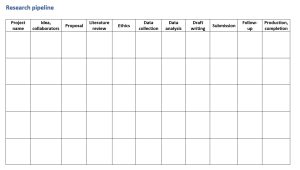
Source: N Brown
The research pipeline is the process of planning and managing publications from an idea through to the completed, finalised submission. I have seen the research pipeline being used as a word document, handwritten notes, but also on a whiteboard with post-it notes. People tend to have their own process and details, but in my case, the pipeline consists of 10 steps or stages. A template for how to maintain the research pipeline can be downloaded from here.
For each project you have on the go, you create one row in the template, so you can tick off the 10 stages as you go along: 1. Idea and collaborators, 2. Proposal 3. Literature review, 4. Ethics, 5. Data collection, 6. Data analysis, 7. Draft writing, 8. Submission, 9. Follow-up and 10. Production and completion.
Here are some questions that will guide you through filling in the research pipeline template:
1. Idea and collaborators
What is your idea? Will you undertake this project on your own or with collaborators? Who are your collaborators?
2. Proposal
Have you written the proposal, yet? Obviously, in some cases, you may not need a formal proposal, but in most cases you will. In fact, having some proposal document ready will be helpful for the ethics approval stage, too.
3. Literature review
Have you undertaken and written a literature review? Again, how important this stage is will depend on the project you have on the go, but if you are collaborating with others, it may help you keep track of the project, as you can highlight whose responsibility this task is.
4. Ethics
Have you written the ethics application? Have you submitted the application and or responded to the feedback? At this stage, sometimes you may be asked to provide more detail on the project, so you may be asked to go back to stage 3. This is not a problem!! It’s just the process of the research pipeline.
5. Data collection
Have you gathered all the data that you need? Sometimes, the data collection stage runs in several phases, in which case it may be useful to keep a record of each phase.
6. Data analysis
Have you analysed your data? What are your findings? Are these sufficient or do you need to go back to stage 5 to collect more data?
7. Draft writing
Have you written a first draft of your work? Have you got sufficient material to complete the article? At this stage, it is worth considering exactly which journal or publisher you are pitching your work to, to make sure you meet their requirements. For most publication submissions, you will need a blinded copy for anonymous review, there will be a specific word count to adhere to, and there will be specifications regarding formatting and referencing. Make sure you are setting up the draft writing with these things in mind, as it makes the process smoother.
8. Submission
This is a fantastic step to have reached! You are now ready to submit your work. Often, there is a long time of waiting at this stage, so it is good you have other work in the pipeline!
9. Follow-up
Follow-up is not meant to be you following up with emails about the process of your publication, although sometimes this will be required, too. Really, this follow-up stage is all about responding to or following up on the comments from the review process. Sometimes, you will receive a “revise and resubmit”. If you do, then make sure you stick to the deadlines set, then go back to stage 8. At other times, you will be asked to submit elsewhere, in which case this project goes back to stage 7; and at some other times, still, you may be told that you need to rework the analysis, so it is back to stage 6. As such, the follow-up stage is really a crunch-point in the research pipeline. It is important that you you distance yourself enough from your work to not take any feedback personal at this stage.
10. Production and completion
Congratulations! Your publication has gone through all the stages, and has been accepted for submission. The publishers will be in touch with you with proofs to check so final edits can be made and last errors corrected. Again, it is best if you stick to the schedule you are given, but ultimately, this is the final stretch and you can soon tick off this project.
As you can see, maintaining an overview of several projects may not be easy with all this going back and forth, which is why a detailed template like this one is really helpful.
Leave a message: